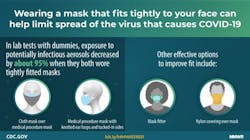CDC reports on maximizing mask fit to improve performance, reduce SARS-CoV-2 transmission
The Centers for Disease Control and Prevention (CDC) conducted experiments to assess two ways of improving the fit of medical procedure masks: fitting a cloth mask over a medical procedure mask and knotting the ear loops of a medical procedure mask and then tucking in and flattening the extra material close to the face, according to a Morbidity & Mortality Weekly Report released by CDC. Each modification substantially improved source control and reduced wearer exposure.
Universal masking is recommended to slow the spread of COVID-19. Cloth masks and medical procedure masks substantially reduce exposure from infected wearers (source control) and reduce exposure of uninfected wearers (wearer exposure). There are multiple simple ways to achieve better fit of masks to more effectively slow the spread of COVID-19.
Universal masking is one of the prevention strategies recommended by CDC to slow the spread of SARS-CoV-2, the virus that causes COVID-19. As of Feb. 1, 2021, 14 states and the District of Columbia had universal masking mandates. Mask wearing has also been mandated by executive order for federal property as well as on domestic and international transportation conveyances.
Masks substantially reduce exhaled respiratory droplets and aerosols from infected wearers and reduce exposure of uninfected wearers to these particles. Cloth masks and medical procedure masks fit more loosely than do respirators (e.g., N95 facepieces). The effectiveness of cloth and medical procedure masks can be improved by ensuring that they are well fitted to the contours of the face to prevent leakage of air around the masks’ edges.
During January 2021, CDC conducted experimental simulations using pliable elastomeric source and receiver headforms to assess the extent to which two modifications to medical procedure masks, 1) wearing a cloth mask over a medical procedure mask (double masking) and 2) knotting the ear loops of a medical procedure mask where they attach to the mask’s edges and then tucking in and flattening the extra material close to the face (knotted and tucked masks), could improve the fit of these masks and reduce the receiver’s exposure to an aerosol of simulated respiratory droplet particles of the size considered most important for transmitting SARS-CoV-2. The receiver’s exposure was maximally reduced (>95 percent) when the source and receiver were fitted with modified medical procedure masks.
Until vaccine-induced population immunity is achieved, universal masking is a highly effective means to slow the spread of SARS-CoV-2 when combined with other protective measures, such as physical distancing, avoiding crowds and poorly ventilated indoor spaces, and good hand hygiene. Innovative efforts to improve the fit of cloth and medical procedure masks to enhance their performance merit attention.
At least two recent studies examined use of mask fitters to improve the fit of cloth and medical procedure masks. Fitters can be solid or elastic and are worn over the mask, secured with head ties or ear loops. The results indicated that when fitters are secured over a medical procedure mask, they can potentially increase the wearer’s protection by ≥90percent for aerosols in the size range considered to be the most important for transmitting SARS-CoV-2 (generally <10 μm). Other studies found that knotting and tucking a medical procedure mask or placing a sleeve made of sheer nylon hosiery material around the neck and pulling it up over either a cloth or medical procedure mask also significantly improved the wearer’s protection by fitting the mask more tightly to the wearer’s face and reducing edge gaps.
A recent expert commentary proposed double masking as another means to improve the fit of medical procedure masks and maximize the filtration properties of the materials from which they are typically constructed, such as spun-bond and melt-blown polypropylene. Based on experiments that measured the filtration efficiencies of various cloth masks and a medical procedure mask, it was estimated that the better fit achieved by combining these two mask types, specifically a cloth mask over a medical procedure mask, could reduce a wearer’s exposure by >90percent.
